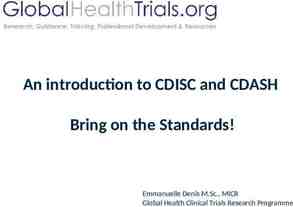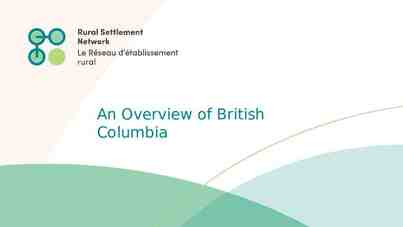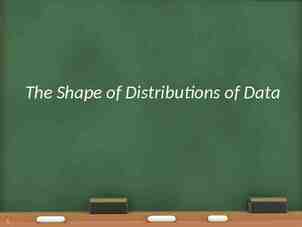Review of Recent Literature on Impacts of Agricultural R&D
19 Slides2.03 MB

Review of Recent Literature on Impacts of Agricultural R&D for Poverty, Nutrition and Resilience Carl E Pray1, William A. Masters2 and Sabrina Ayoub1 1. Rutgers Univ., Dept. of Agricultural, Food & Resource Economics and Feed the Future Policy Research Consortium ([email protected]) 2. Tufts University, Friedman School of Nutrition Science & Policy and Feed the Future Innovation Lab for Nutrition ([email protected])

Overview of results Agricultural R&D is still among the highest-return public investments – No decline over time or lower returns in specific regions – Gains arise from higher productivity of land and labor in target locations – Large impacts on poverty, nutrition and resilience Impacts revealed by diverse kinds of evidence – Individual household data for adoption and response to innovation – Aggregate country data for systemic change & structural transformation – Modeling food systems to estimate rates of return and private sector growth Recent history can help guide research priorities – To lower poverty, aim for large targets (species & systems) in poor places – To improve nutrition, aim at purchasing power for better diets (income/prices) – To improve resilience, aim at level and stability of poverty/nutrition outcomes 2

Outline of presentation Methodology for systematic literature review Causal mechanisms and types of evidence Principal results – Poverty – Nutrition – Resilience Implications for priority-setting 3

Methodology for systematic literature review Topic is longstanding and broadly defined, so we focus on: – recent studies (most are since 2010, earliest cited is 1996) – peer-reviewed, high-impact work (mostly journals, include gray literature) – target regions (mostly Africa and South Asia, some Latin America) – relevance for specific objectives (poverty, nutrition and resilience) Research uses diverse methods and terminology – repeated searches with different search terms – personal outreach to individual scholars and practitioners Research uses different kinds of data: – Qualitative studies (for questions without numerical data) – Statistical estimates (both household surveys and aggregate data) – Simulation models (built from statistically-estimated components) 4

Causal mechanisms and types of evidence Impacts of R&D occur through systemic change 5 Source: Pathways diagram from Oehmke et al. 2010; photos from W. A. Masters

Causal mechanisms and types of evidence Adding nutrition and resilience requires even more data Source: Masters, Webb, Griffiths, & Deckelbaum (2014), 6 modified from Gillespie, Harris and Kadiyala (2012).

Principal results – driving force is productivity Country-level data on systemic change reveals how public ag R&D is a key lever to raise outputs/inputs (total factor productivity, TFP) Fuglie et al. (2012): over 87 countries from 1961 to 2009, agricultural TFP accounted for 40% of the sector’s growth, driven by R&D Fuglie and Rada (2012): focusing on 37 SSA countries since 1977, public R&D accounts for all the TFP turnaround and growth since 1981 Country studies find that at some places & times (e.g. Brazil, India) public research has large direct impacts visible in the data; elsewhere (Indonesia, China) the data are dominated by changes in trade policy, infrastructure and institutional changes 7

Principal results – links to private investment Public research drives growth by attracting private investment, on and off the farm; privately-financed R&D still very low in Africa Private R&D and TFP in US (Huffman & Evenson 2006) and India (Evenson, Rosegrant & Pray 1998) Private R&D adds proprietary components to public domain knowledge, skills and market opportunities, e.g. for Poultry (Narrod & Pray 2001) Hybrid maize, millet and sorghum (Pray & Fuglie 2014) GMO cotton, maize and soybeans (Pray & Fuglie 2014) 8

Principal results – rates of return Impacts are summarized by return on investment – Hurley et al. (2016): Over 2,600 estimates from 492 studies in 85 countries reveal high returns in all time periods, sub-sectors and geographic regions Estimated rates of return to food and agriculture R&D investment in Africa (SSA, n 376) and the rest of the world (ROW, n 2,251) Source: Pardey, P.G., Andrade, R.S., Hurley, T.M., Rao, X. and Liebenberg, F.G., 2016. Returns to food and agricultural R&D investments in Sub-Saharan Africa, 1975–2014. Food Policy, 65, pp.1-8. 9

Principal results – examples of high returns Impacts are summarized by return on investment – Raitzer & Maredia (2006) use data from 23 studies to aggregate the total costs and benefits of CGIAR–NARS partnership investments in SSA for the period 1966–2004. US 17 billion investments generated benefits of 26-28 billion – Jutzi and Rich (2016) focusing on livestock find high ROI from rinderpest eradication, goat parasites, dairy policy change, new forages, and natural resource management, but not control of avian influenza 10

Principal results – poverty reduction Thirtle, Lin and Piesse (2003) across 48 developing countries: 10% increase in ag research reduces poverty by 1% Thirtle and Piesse (2007), more detail: – research increases yield/ha, – yield/ha increases income, reduces inequality (except in Latin America) – increasing income and reducing inequality reduces poverty Alene and Coulibaly (2009) 28 countries of SSA,1980 to 2003 – R&D expenditures by CGIAR centers in Africa and by African governments increased agricultural value added/hectare, – value added/hectare increases average income, – increased average income reduces the poverty rate – doubling research investment would reduce poverty by 8% 11

Principal results – examples of poverty impacts Authors Location Subsector Research on production agriculture Asfaw, Kassie, Tanzania Pigeon pea public Simtowe & Lipper, 2011. Method Outcome Ex post adoption and poverty reduction Adoption of improved pigeon pea varieties significantly decreased inequality & severity of poverty, by 4.4–8.1 percentage points Chagunda et al., 2016 SSA Improved dairy technology In Sub-Saharan Africa (SSA), smallholder dairy improved with 3 approaches: ecological, genetic, and socio-economic intensification Larochelle, 2015 Uganda/ Rwanda: Common beans Common beans CIAT Ex post adoption and poverty reduction Moyo, Norton, Eastern Alwang, Rhinehart, Uganda & Deom, 2007 Peanuts. Public sector in Uganda, by ICRISAT in Malawi, Ex ante impact analysis of Full adoption would give 10.5% decline in severity adopting Rosette-resistant of poverty. seed varieties by all peanut producers Oehmke et al., 2011 Kenya USAID supported productivity programs for maize, livestock and vegetables Ex post analysis using Tegemeo panel of HHs Between 2004 and 2008, net poverty in the direct treatment group decreased by 4.9%. Among indirect beneficiaries of the programs, a net poverty rate reduction of 9.9%. In 2006- 2008, poverty among female-headed households potentially benefitting from the USAID programs declined from 76% to 67%. Zeng et al., 2015 Ethiopia Maize varieties from CGIAR Ex post based on survey data 0.8-1.3% decline in poverty due to adoption but the poor benefitted least because of their small land holdings Impacts on poverty were 0.4% in Rwanda and 0.1% in Uganda, proportional to small area & small part of diet 12

Principal results – postharvest food systems The main driver of R&D impacts is higher primary productivity (more of all outputs per unit of land, labor and other inputs) but post-harvest food systems are also important targets: Postharvest R&D can: – reduce product losses, save labor and lower food costs: Hermetic storage of grain improved food security for the poor in Kenya (Gitonga et al. 2013) Mechanization of cassava processing reduced poverty rates in Zambia (Abass et al. 2017) – improve quality of output: Insect resistant maize reduces mycotoxin exposure for the poor in South Africa (Pray et al 2013) Development of small-scale milk vendor systems improved diet quality for the poor and generated a 55% ROR in Kenya (Kaitibie et al. 2010) 13

Principal results – R&D impacts on nutrition The main impacts of R&D are through increased supply and lower average cost of food relative to poor peoples’ incomes Source: Evenson and Gollin, 2003. 14

Principal results – R&D impacts on nutrition Beyond food prices relative to incomes, other data reveals systemic impacts on nutrition and health: Barnwell et al. 2017 find that modern variety (MV) introduction led to a large declines in infant mortality, using DHS data on 600,000 births in 37 developing countries Masters et al. 2014 find that agricultural productivity drives establishment of towns and cities, which in turn improves nutrition of children who remain in rural areas (Darrouzet-Nardi and Masters 2015) 15

Principal results – R&D impacts on resilience Pathways by which agricultural research have increased resilience of farm households include: Development of farm inputs that stabilize production itself, by reducing vulnerability to biotic stress (insects, diseases), abiotic stress (moisture, temperature, soils) and increasing diversity (Smale 2006, Lipper et al. 2010, Michler et al. 2016) Development of food markets and other services that allow “nutrition smoothing” against seasonal and annual shocks (Darrouzet-Nardi and Masters 2017, Mulmi et al. 2016). Development of agrifood policies and programs to reduce vulnerability such as safety nets and insurance systems (Janzen and Carter 2013, Jensen and Barrett 2016) 16

Principal results – synergies with other public investments Effects of R&D investment scenarios (MED-REGION) show trade-offs, complementarities with irrigation (IX), water saving (ISW) & infrastructure (RMM) Source: Rosegrant et al. 2016 Notes: Strategic objectives are SLO1: Reduced poverty, SLO2: Improved food and nutrition security and health, SLO3: Improved natural resource systems and ecosystem services. Policy scenarios are as defined in Table 4. 17

Conclusion -- implications for priority setting Agricultural research remains the highest-return driver to reduce poverty, improve nutrition and build resilience. To reach specific objectives more quickly, use a sequence of investment criteria such as the following: 1. Poverty: Is the investment likely to raise real incomes for those at risk? aim for large targets (species & systems) in poor places 2. Nutrition: Is the investment likely to lower the real cost of nutritious food, and improve non-food influences on nutrition outcomes? aim for lower real cost of better diets (food prices relative to incomes), and also limit disease exposure, empower household caregivers 3. Resilience: Is the investment likely to stabilize real income, food costs and other influences on poverty and nutrition? aim to address large and growing stressors (both biotic and abiotic) 18

Thank you! Carl E Pray1, William A. Masters2 and Sabrina Ayoub1 1. Rutgers Univ., Dept. of Agricultural, Food & Resource Economics and Feed the Future Policy Research Consortium ([email protected]) 2. Tufts University, Friedman School of Nutrition Science & Policy and Feed the Future Innovation Lab for Nutrition ([email protected])






